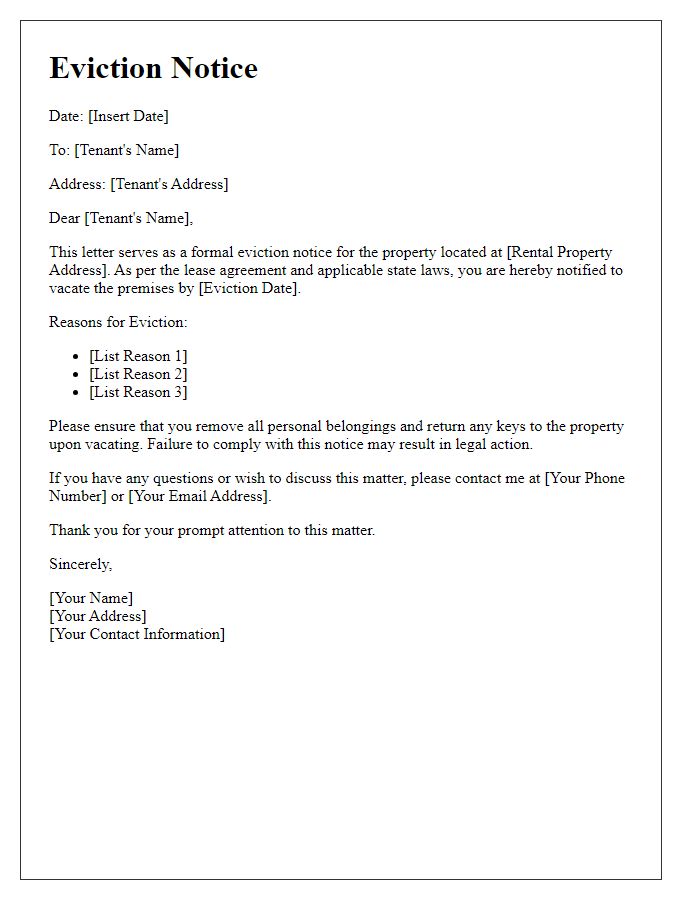Are you feeling overwhelmed by the eviction process and unsure of what steps to take? You're not alone; many people find the legalities confusing and stressful. In this article, we'll break down the eviction process into clear, manageable steps, helping you understand your rights and responsibilities. So, grab a cup of coffee and let's dive deeper into the ins and outs of eviction!

Tenant Identification
Eviction processes often begin with tenant identification, requiring specific information such as full names, addresses, and lease agreement details. Accurate identification ensures all communications are directed to the respective tenant residing at the property, which may be located in cities like Los Angeles, New York, or Chicago. Eviction notices must include precise lease terms, payment history, and any violations of rental agreements. Local laws, such as those outlined in the California Civil Code or New York State Real Property Law, dictate the necessary steps for eviction, including notice periods which may range from three to thirty days, depending on the nature of the eviction grounds. Confirming tenant identity also aids in avoiding disputes regarding unauthorized occupants, ensuring a smoother eviction process.
Lease Agreement Summary
Eviction processes can vary significantly based on lease agreements and local laws. Typical lease agreements outline essential elements such as the duration, rental amount, payment schedule, and conditions for termination. Evictions often stem from reasons like non-payment of rent, lease violations, or property damage. In many jurisdictions, landlords are required to provide written notice, specifying the grounds for eviction and allowing tenants time to rectify issues. Local laws (such as those in California's Civil Code 1946.2) may dictate specific timelines for notices, often ranging from three to thirty days. Understanding these stipulations is crucial for both landlords and tenants to navigate the eviction process effectively.
Reason for Eviction
Eviction notices serve as formal communications outlining the reasons for tenant removal from rental properties, such as violations of lease agreements. Common causes include non-payment of rent, where tenants fail to pay amounts due by the specified deadline each month, or lease violations, which may encompass unauthorized pets, property damage exceeding normal wear and tear, or engaging in illegal activities on the premises. Additionally, tenants may be evicted for failure to comply with rules established by property management, such as noise ordinances or parking regulations. In specific jurisdictions, the eviction process must follow local laws, which may dictate notice periods, court proceedings, and required documentation to substantiate claims against tenants, ensuring a legal and orderly removal from the property.
Legal References and Compliance
The eviction process in the United States involves several legal steps that must be carefully followed to ensure compliance with local and state laws. Documentation such as the notice to quit or notice to vacate is typically required, depending on state regulations, giving tenants notice of their lease violations or the termination of rental agreements. Research is essential to determine legal timeframes, which can vary from 3 days to 30 days based on jurisdiction. Courts, particularly in counties like Los Angeles or Cook County, require specific forms to initiate the unlawful detainer lawsuit, detailing the grounds for eviction, such as non-payment of rent or lease violations. Tenants have the right to contest the eviction in court, often leading to hearings where both parties present evidence. Familiarity with local statutes, such as the Fair Housing Act or state landlord-tenant laws, is crucial to avoid potential legal pitfalls during the eviction process. Failure to properly document each step can lead to delays or dismissal of the case, making adherence to statutory requirements critical for landlords.
Next Steps and Timelines
Eviction proceedings in the United States typically follow a series of legal steps, beginning with the issuance of a formal notice to quit or pay rent, often referred to as a "Pay or Quit" notice, which usually provides tenants with a timeframe of anywhere from 3 to 14 days to remedy the situation. Following the notice period, if the tenant fails to comply, landlords can file an eviction lawsuit, known as an unlawful detainer action, in the local court, with timelines varying by jurisdiction, usually taking between 1 to 3 weeks for a hearing. Once a court judgment is rendered, if in favor of the landlord, a further notice may be issued, allowing the sheriff or constable to enforce the eviction, typically scheduled within 5 to 30 days based on local laws. It is crucial for both parties to document all communications and retain copies of notices for legal purposes during this process.













Comments